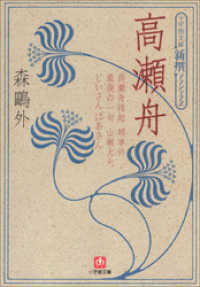- ホーム
- > 洋書
- > ドイツ書
- > Mathematics, Sciences & Technology
- > Physics and Astronomy
- > electricity, magnetism, optics
基本説明
New in softcover. Hardcover was published in 1994.
Full Description
Based on courses given at the Ecole Polytechnique in France, this book covers not only the fundamental physics of semiconductors, but also discusses the operation of electronic and optical devices based on semiconductors. It is aimed at students with a good background in mathematics and physics, and is equally suited for graduate-level courses in condensed-matter physics as for self-study by engineers interested in a basic understanding of semiconductor devices.
Contents
1 Simple Ideas about Semiconductors.- 1.1 Definition and Importance of Semiconductors.- 1.2 A Chemical Approach to Semiconductors.- 1.3 Quantum States of a Perfect One-Dimensional Crystalline Solid.- 2 Quantum States of a Perfect Semiconductor.- 2.1 Quantum States of a Three-Dimensional Crystal.- 2.2 Dynamics of a Bloch Electron. The Crystal Momentum.- 2.3 Metal, Insulator, Semiconductor.- 2.4 Theoretical Determination of Band Structure.- 2.5 The True Band Structure.- 2.6 Experimental Study of Band Structure.- Appendix 2.1 Matrix Element of a Periodic Operator between Two Bloch States.- Appendix 2.2 Symmetries of the Band Structure.- Appendix 2.3 Band Structure of Column IV Elements Calculated by the LCAO Method.- Appendix 2.4 The k • p Method.- 3 Excited States of a Pure Semiconductor and Quantum States of Impure Semiconductors.- 3.1 The Hole Concept.- 3.2 Impurities in Semiconductors.- 3.3 Impurity Bands.- Appendix 3.1 Problems on Cyclotron Resonance in Silicon.- Appendix 3.2 QuantumWells and Semiconducting Superlattices.- Appendix 3.3 Amorphous Semiconductors.- 4 Statistics of Homogeneous Semiconductors.- 4.1 Occupation of the Electron Levels.- 4.2 Hole Occupation.- 4.3 Determination of the Chemical Potential.- 4.4 Statistics of Pure or Intrinsic Semiconductors.- 4.5 Statistics of a Semiconductor Containing Impurities: The Notion of Majority and Minority Carriers.- 4.6 Compensated Semiconductor at Intermediate Temperature.- 4.7 Semiconductor at Low Temperatures.- 4.8 Application: The Semiconducting Thermometer.- 4.9 Growth of Pure Crystals.- Appendix 4.1 Occupation Number of a Donor Level.- Appendix 4.2 Problem: Substrates for Microelectronics.- 5 Transport Phenomena in Semiconductors.- 5.1 Introduction.- 5.2 Drude's Model of Conductivity and Diffusion.- 5.3 Semiclassical Treatment of Transport Processes.- 5.4 The Mobility of Semiconductors.- Appendix 5.1 Problems on the Hall Effect and Magnetoresistance of Semiconductors in the Drude Model.- 6 Effects of Light.- 6.1 Light Absorption by Semiconductors.- 6.2 Recombination.- 6.3 Photoconductivity and its Applications.- Appendix 6.1 Quantum System Submitted to a Sinusoidally Varying Perturbation.- Appendix 6.2 Calculation of the Radiative Recombination Probability.- Appendix 6.3 Semiconducting Clusters for Non-Linear Optics.- 7 Carrier Injection by Light.- 7.1 Basic Equations for Semiconductor Devices.- 7.2 Charge Neutrality.- 7.3 Injection or Extraction of Minority Carriers.- Appendix 7.1 Charge Quasi-Neutrality.- Appendix 7.2 Problems on Photoexcitation, Recombination, and Photoconductivity.- 8 The p—n Junction.- 8.1 Introduction: Inhomogeneous Semiconductors.- 8.2 The Equilibrium p—n Junction.- 8.3 The Non-Equilibrium Junction.- Appendix 8.1 Problem: Non-Stationary p—n Junctions and their High-Frequency Applications.- 9 Applications of the p—n Junction and Asymmetrical Devices.- 9.1 Applications of p—n Junctions.- 9.2 The Metal-Semiconductor Contact in Equilibrium.- 9.3 Non-Equilibrium Metal-Semiconductor Junction.- 9.4 The Semiconductor Surface.- 9.5 Photoemission from Semiconductors.- 9.6 Heterojunctions.- 10 The Principles of Some Electronic Devices.- 10.1 The Junction Transistor.- 10.2 The Field-Effect Transistor.- 10.3 An Application of the MOSFET: The Charge-Coupled Device (CCD).- 10.4 Concepts of Integration and Planar Technology.- 10.5 Band Gap Engineering.- 10.6 Physical Limits in Digital Electronics.- Appendix 10.1 Problems on the n—p—n Transistor.- Appendix 10.2 Problems on the Junction Field-Effect Transistor.- Appendix 10.3 Problems on MOS (Metal-Oxide-Semiconductor) Structure.- Values of the Important Physical Constants.- Some Physical Properties of Semiconductors.








